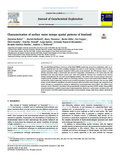| dc.contributor.author | Birkel, Christian | |
| dc.contributor.author | Helliwell, Rachel | |
| dc.contributor.author | Thornton, Barry | |
| dc.contributor.author | Gibbs, Sheila | |
| dc.contributor.author | Cooper, Pat | |
| dc.contributor.author | Soulsby, Chris | |
| dc.contributor.author | Tetzlaf, Doerthe | |
| dc.contributor.author | Spezia, Luigi | |
| dc.contributor.author | Esquivel-Hernández, Germain | |
| dc.contributor.author | Sánchez-Murillo, Ricardo | |
| dc.contributor.author | Midwood, Andrew J. | |
| dc.date.accessioned | 2020-03-19T22:53:15Z | |
| dc.date.available | 2020-03-19T22:53:15Z | |
| dc.date.issued | 2018-07-24 | |
| dc.identifier.uri | https://doi.org/10.1016/j.gexplo.2018.07.011 | |
| dc.identifier.uri | http://hdl.handle.net/11056/17255 | |
| dc.description | Sánchez-Murillo, Ricardo (Ricardo Alonso Sánchez Murillo) | es_ES |
| dc.description.abstract | The extended National Waters Inventory of Scotland (NWIS) monitoring network in combination with an extensive, supplementary low flow sampling campaign was used to create isoscapes of surface water for management purposes at high spatial resolution (100 m grid) across Scotland. The δ2
H isoscape shows a strong
isotopic separation along a north-south and east-west topographic (mountainous to the north and west and
lowlands to the east) and climatic (wetter west, drier east) gradients. Isotopes were enriched in the western
domain and depleted in the east and central Highland domains. The surface water d-excess isoscape show more
complex spatial variability mainly related to contrasting moisture sources (sub-tropical North Atlantic Ocean,
the North Sea, Polar Continental, and the Arctic) as well as secondary evaporation processes. The two-year NWIS
isotope record exhibited a significant seasonal evaporative effect on surface water isotopes that progresses from
winter through to a maximum in autumn as indicated by Local Evaporation Lines (LELs). The surface water
isoscapes can be efficiently reproduced with geographically weighted regression (GWR) models using gridded
annual precipitation, remotely sensed actual evapotranspiration, land cover, soil wetness, catchment area, and
mean elevation. The GWR models showed potential to assess isotopic changes under future climate and land use
change. | es_ES |
| dc.language.iso | en | es_ES |
| dc.publisher | Elsevier B.V. | es_ES |
| dc.subject | Isotopes | es_ES |
| dc.subject | Superficial water | es_ES |
| dc.subject | United Kingdom | es_ES |
| dc.subject | Isótopos | es_ES |
| dc.subject | Agua superficial | es_ES |
| dc.subject | Reino Unido | es_ES |
| dc.title | Characterization of surface water isotope spatial patterns of Scotland | es_ES |
| dc.type | http://purl.org/coar/resource_type/c_6501 | es_ES |

